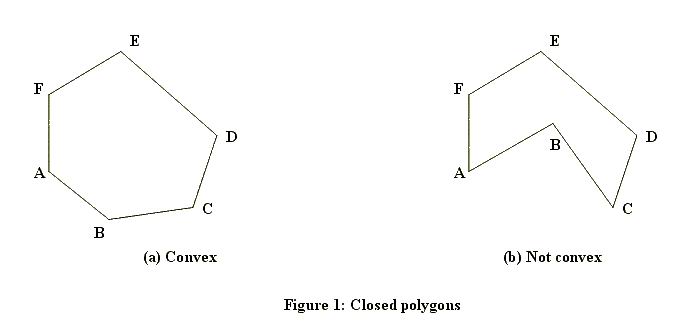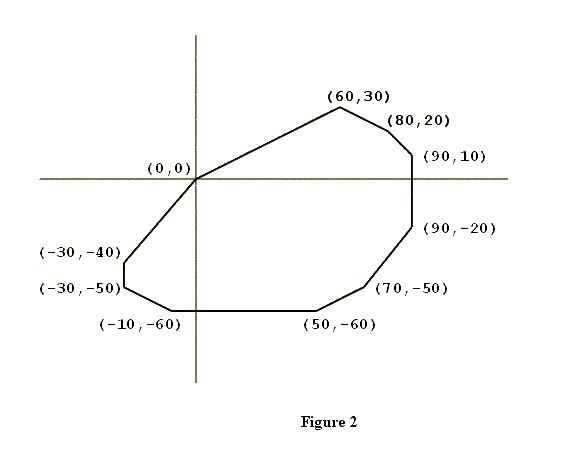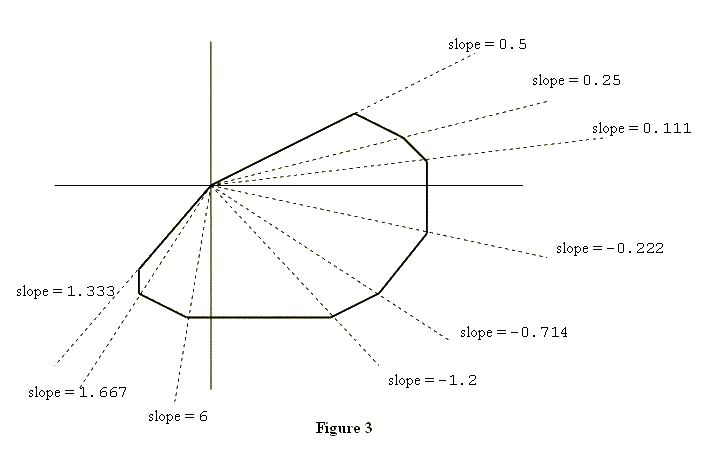poj 2007 凸包构造和极角排序输出(模板题)
| Time Limit: 1000MS | Memory Limit: 30000K | |
| Total Submissions: 10841 | Accepted: 5085 |
Description
A closed polygon is called convex if the line segment joining any two points of the polygon lies in the polygon. Figure 1 shows a closed polygon which is convex and one which is not convex. (Informally, a closed polygon is convex if its border doesn't have any "dents".)

The subject of this problem is a closed convex polygon in the coordinate plane, one of whose vertices is the origin (x = 0, y = 0). Figure 2 shows an example. Such a polygon will have two properties significant for this problem.
The first property is that the vertices of the polygon will be confined to three or fewer of the four quadrants of the coordinate plane. In the example shown in Figure 2, none of the vertices are in the second quadrant (where x < 0, y > 0).
To describe the second property, suppose you "take a trip" around the polygon: start at (0, 0), visit all other vertices exactly once, and arrive at (0, 0). As you visit each vertex (other than (0, 0)), draw the diagonal that connects the current vertex with (0, 0), and calculate the slope of this diagonal. Then, within each quadrant, the slopes of these diagonals will form a decreasing or increasing sequence of numbers, i.e., they will be sorted. Figure 3 illustrates this point.


Input
Output
Sample Input
0 0
70 -50
60 30
-30 -50
80 20
50 -60
90 -20
-30 -40
-10 -60
90 10
Sample Output
(0,0)
(-30,-40)
(-30,-50)
(-10,-60)
(50,-60)
(70,-50)
(90,-20)
(90,10)
(80,20)
(60,30)
#include<iostream>
#include<cmath>
#include<algorithm>
#include<cstdio>
using namespace std; const int MAXN =55;
const double PI= acos(-1.0);
//精度
double eps=1e-8;
//避免出现-0.00情况,可以在最后加eps
//精度比较
int sgn(double x)
{
if(fabs(x)<=eps)return 0;
if(x<0)return -1;
return 1;
} //点的封装
struct Point
{
double x,y;
Point (){}
//赋值
Point (double _x,double _y)
{
x=_x;
y=_y;
}
//点相减
Point operator -(const Point &b)const
{
return Point (x-b.x,y-b.y);
}
//点积
double operator *(const Point &b)const
{
return x*b.x+y*b.y;
}
//叉积
double operator ^(const Point &b)const
{
return x*b.y-y*b.x;
}
} ; //线的封装
struct Line
{
Point s,e;
Line (){}
Line (Point _s,Point _e)
{
s=_s;
e=_e;
}
//平行和重合判断 相交输出交点
//直线相交和重合判断,不是线段,
Point operator &(const Line &b)const{
Point res=b.s;
if(sgn((e-s)^(b.e-b.s))==0)
{
if(sgn((e-s)^(e-b.e))==0)
{
//重合
return Point(0,0);
}
else
{
//平行
return Point(0,0);
}
}
double t=((e-s)^(s-b.s))/((e-s)^(b.e-b.s));
res.x+=(b.e.x-b.s.x)*t;
res.y+=(b.e.y-b.s.y)*t;
return res;
}
}; //向量叉积
double xmult(Point p0,Point p1,Point p2)
{
return (p0-p1)^(p2-p1);
} //线段和线段非严格相交,相交时true
//此处是线段
bool seg_seg(Line l1,Line l2)
{
return sgn(xmult(l1.s,l2.s,l2.e)*xmult(l1.e,l2.s,l2.e))<=0&&sgn(xmult(l2.s,l1.s,l1.e)*xmult(l2.e,l1.s,l1.e))<=0;
} //两点之间的距离
double dist(Point a,Point b)
{
return sqrt((a-b)*(a-b));
} //极角排序;对100个点进行极角排序
int pos;//极点下标
Point p[MAXN];
int Stack[MAXN],top;
bool cmp(Point a,Point b)
{
double tmp=sgn((a-p[pos])^(b-p[pos]));//按照逆时针方向进行排序
if(tmp==0)return dist(a,p[pos])<dist(b,p[pos]);
if(tmp<0)return false ;
return true;
}
void Graham(int n)
{
Point p0;
int k=0;
p0=p[0];
for(int i=1;i<n;i++)//找到最左下边的点
{
if(p0.y>p[i].y||(sgn(p0.y-p[i].y))==0&&p0.x>p[i].x)
{
p0=p[i];
k=i;
}
}
swap(p[k],p[0]);
sort(p+1,p+n,cmp);
if(n==1)
{
top=2;
Stack[0]=0;
return ;
}
if(n==2)
{
top=2;
Stack[0]=0;
Stack[1]=1;
return ;
}
Stack[0]=0;Stack[1]=1;
top=2;
for(int i=2;i<n;i++)
{
while(top>1&&sgn((p[Stack[top-1]]-p[Stack[top-2]])^(p[i]-p[Stack[top-2]]))<=0)
top--;
Stack[top++]=i;
}
} int main ()
{
int t=0;
while(~scanf("%lf%lf",&p[t].x,&p[t].y))
t++;
Graham(t);
for(int i=0;i<t;i++)
{
if(p[i].x==0&&p[i].y==0)
{
swap(p[i],p[0]);
break;
}
}
sort(p,p+t,cmp);
for(int i=0;i<t;i++)
printf("(%.f,%.f)\n",p[i].x,p[i].y);
return 0;
}
极角排序:
根据逆时针顺序进行排序
poj 2007 凸包构造和极角排序输出(模板题)的更多相关文章
- poj 2007 Scrambled Polygon(极角排序)
http://poj.org/problem?id=2007 Time Limit: 1000MS Memory Limit: 30000K Total Submissions: 6701 A ...
- poj 1696:Space Ant(计算几何,凸包变种,极角排序)
Space Ant Time Limit: 1000MS Memory Limit: 10000K Total Submissions: 2876 Accepted: 1839 Descrip ...
- poj 1696 Space Ant (极角排序)
链接:http://poj.org/problem?id=1696 Space Ant Time Limit: 1000MS Memory Limit: 10000K Total Submissi ...
- POJ 1696 Space Ant 【极角排序】
题意:平面上有n个点,一只蚂蚁从最左下角的点出发,只能往逆时针方向走,走过的路线不能交叉,问最多能经过多少个点. 思路:每次都尽量往最外边走,每选取一个点后对剩余的点进行极角排序.(n个点必定能走完, ...
- POJ 1696 Space Ant(极角排序)
Space Ant Time Limit: 1000MS Memory Limit: 10000K Total Submissions: 2489 Accepted: 1567 Descrip ...
- POJ 2280 Amphiphilic Carbon Molecules 极角排序 + 扫描线
从TLE的暴力枚举 到 13313MS的扫描线 再到 1297MS的简化后的扫描线,简直感觉要爽翻啦.然后满怀欣喜的去HDU交了一下,直接又回到了TLE.....泪流满面 虽说HDU的时限是2000 ...
- 【计算几何】【凸包】【极角排序】【二分】Gym - 101128J - Saint John Festival
平面上n个红点,m个黑点,问你多少个黑点至少在一个红三角形内. 对红点求凸包后,转化为询问有多少个黑点在凸包内. 点在凸多边形内部判定,选定一个凸包上的点作原点,对凸包三角剖分,将其他的点极角排序之后 ...
- poj 3683 2-sat建图+拓扑排序输出结果
发现建图的方法各有不同,前面一题连边和这一题连边建图的点就不同,感觉这题的建图方案更好. 题意:给出每个婚礼的2个主持时间,每个婚礼的可能能会冲突,输出方案. 思路:n个婚礼,2*n个点,每组点是对称 ...
- POJ 1981 最大点覆盖问题(极角排序)
Circle and Points Time Limit: 5000MS Memory Limit: 30000K Total Submissions: 8346 Accepted: 2974 ...
随机推荐
- 【JDBC核心】获取数据库连接
获取数据库连接 要素一:Driver 接口实现类 Driver 接口: java.sql.Driver 接口是所有 JDBC 驱动程序需要实现的接口.这个接口是提供给数据库厂商使用的,不同数据库厂商提 ...
- 【Java基础】Java8 新特性
Java8 新特性 Lambda 表达式 Lambda 是一个匿名函数,我们可以把 Lambda 表达式理解为是一段可以传递的代码(将代码像数据一样进行传递).使用它可以写出更简洁.更灵活的代码. L ...
- Python基础语法3-输入、输出语句
- Azure Terraform(五)利用Azure DevOps 实现自动化部署基础资源
一,引言 上一篇我们结合学习 Azure Traffic Manger 的内容,做了一个负载均衡的基础设施架构.通过 Terraform 部署执行计划,将整个 Azure Traffic Manage ...
- Docker相关简介以及使用方法
Docker: 可以把它看作是一个软件,在这个软件当中呢,还可以安装其他的软件,还可以把软件所需要的环境依赖一起添加进来,这样让开发人员的程序在不同的环境当中都可以流转起来,避免了程序出现" ...
- Django中多表关联的展示问题:
增加一个知识点,当表中有多对多关联时,在前端展示的时候是一个列表,所以在展示的时候需要这样做: 表结构: class ProjectEnv(models.Model): project = model ...
- 记一次ceph pg unfound处理过程
今天检查ceph集群,发现有pg丢失,于是就有了本文~~~ 1.查看集群状态 [root@k8snode001 ~]# ceph health detail HEALTH_ERR 1/973013 o ...
- GlusterFS分布式存储系统复制集更换故障Brick操作记录
场景: GlusterFS 3节点的复制集,由于磁盘故障,其中一个复制集需要重装系统,所以需要重装glusterfs并将该节点加入glusterfs集群 一. 安装GlusterFS 首先在重装系统节 ...
- nothreading use single threaded
threading: # ThreadingMixIn.daemon_threads indicates how threads will behave on an # abrupt shut ...
- TCP半连接队列和全连接
概述 如上图所示, 在TCP三次握手中,服务器维护一个半连接队列(sync queue) 和一个全连接队列(accept queue). 当服务端接收到客户端第一次SYN握手请求时,将创建的req ...
